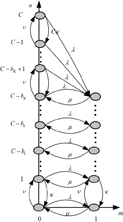Algorithm for Calculating QoS Parameters of Video Conferencing and Video on Demand Services in Wireless Next Generation Networks*
Received November 2014; Accepted March 2015
Vladimir Y. Borodakiy1, Konstantin E. Samouylov2, Irina A. Gudkova2 and Ekaterina V. Markova2
- 1JSC “Concern Sistemprom”, Moscow, Russia
- 2Department of Applied Probability and Informatics, Peoples’ Friendship University of Russia, Moscow, Russia
- E-mail: bvu@systemprom.ru; ksam, igudkova, emarkova@sci.pfu.edu.ru
Abstract
The standardization of 5G wireless next generation networks is planned to be started by 3GPP consortium in 2020. Nevertheless, for today, there is the lack of QoS related 3GPP and ITU-T recommendations describing various popular services, for example video conferencing. The problem is to find the optimal bit rate values for this service not affecting the background lower priority services. In this paper, we propose a tool to solve this problem. The tool includes, first, a mathematical model of pre-emption based radio admission control scheme for video conferencing and background video on demand, and second, an effective algorithm for calculating QoS parameters for these services. The results of the paper could be used to find the optimal bit rates for video conferencing and further develop a proposition for standardization activities in video conferencing recommended parameters.
Keywords
- 5G
- LTE
- video conferencing
- video on demand
- radio admission control
- pre-emption
- service degradation
- service interruption
- QoS
- blocking probability
- pre-emption probability
- mean bit rate
- teletraffic theory
- queuing theory
1 Introduction
We perceive emerging developments in ICTs in various areas of our dynamic life. The concept of getting services and applications “at any time” and “in any place” imposes the corresponding development in wireless next generation networks. The rapid worldwide deployment of 4G LTE [1] cellular networks as well as the further its development towards 5G and the increasing demand for new services are the key ICT trends that highlight the need for future improvements in technologies underlying LTE. Although 3GPP (3ed Generation Partnership Project) consortium concentrates all standardization activities in LTE (see TS 36.300 for a description of the LTE architecture), ITU-T recommendations reflect the main quality of service (QoS) requirements in ICTs. Nevertheless, QoS related ITU-T recommendations (i.e. E.800–E.899, G.1000–G.1999, Y.1500–Y.1599, Y.2100–Y.2199 series) do not describe all the variety of products and services provided by cellular networks. This fact raises the need for updates in these recommendations for 4G and further 5G recommendations. In 2020, 3GPP plans to release the first set of specifications that will define 5G networks. Until 2020, 3GPP proposes to conduct scientific research for 5G specifications development. Thus, until 2020, there will be no standardized solutions, methods and technologies for 5G networks. Therefore, an important task is to develop offers for improving the technological base of 4G networks towards 5G.
LTE and LTE-Advanced networks deployment is inseparably linked with maintaining the quality of service (QoS) and enhancing customer base. Meeting the corresponding radio resource related requirements is the primarily aim of the radio resource management (RRM). Managing radio resources encompasses the radio admission control (RAC), dynamic resource allocation, inter-cell interference coordination (ICIC), etc. RAC schemes are closely related to the types of services provided to customers. The 3GPP specifications (TS 36.300, TS 23.401, TS 23.203) for LTE and LTE-Advanced networks specify nine service classes (QoS class identifier, QCI) that differ in terms of the bit rate, priority level, and packet error loss.
Each of the nine service classes could be provided on guaranteed bit rate (GBR) or on non-guaranteed bit rate (non-GBR). The first four classes are GBR services, for example, video on demand (VoD), other five classes are non-GBR services, for example, web browsing, email. GBR services could be provided not only on one value of bit rate. Its bit rate can change from a maximum value – the so-called maximum bit rate (MBR) – to a minimum value – GBR – depending on the cell load and RAC scheme. This bit rate changes do not alter the service duration. Whereas, the bit rate changes for non-GBR services result in varying the service duration. According to these principles, in terms of teletraffic and queuing theories, services provided on GBR correspond to streaming traffic, services provided without GBR correspond to elastic traffic. In accordance with two communication technologies point-to-point and point-to-multipoint streaming traffic is divided into two subtypes – unicast and multicast traffic. Unlike unicast traffic, multicast traffic has a network resources saving nature, which is achieved through employing multicast technology. So, overall LTE traffic may be divided into three types: unicast streaming, multicast streaming, and elastic traffics.
Each of service classes is associated with a key attribute called the allocation and retention priority (ARP). The value of ARP is used by the RAC as a flag for admitting or rejecting requests of users for service providing. According to 3GPP TS 23.203, “The range of the ARP priority level is 1 to 9 with 1 as the highest level of priority. The pre-emption capability information defines whether a service data flow can get resources that were already assigned to another service data flow with a lower priority level. The pre-emption vulnerability information defines whether a service data flow can lose the resources assigned to it in order to admit a service data flow with a higher priority level.” In accordance with this definition ARP contains three information fields, namely, priority value, pre-emption capability and pre-emption vulnerability. The priority value is used for differentiation purposes and it ensures that the request for service with a higher priority level will be accepted. Note that the highest priority, which is equal to one, has signalling traffic, followed by GBR services – priority values from two to five – and the last non-GBR services have the lowest priority from the sixth to the ninth.
From the above 3GPP definition of “pre-emption”, it is evident that during the lack of radio resources, assigning it to lower priority services could be realized, at best, through the service degradation, which is also referred to as bandwidth adaptation or partial pre-emption, or, at worst, through the service interruption, which is also referred to as cut off process or full pre-emption. The 3GPP specifications do not specify RAC schemes, and operators have to develop and select an optimal scheme accounting for the service level agreement. Researchers have proposed various RAC schemes [2–6] with different approaches to pre-empting. Nevertheless, the basic principle of service degradation and interrupting holds.
The admission control is realized on the bit rate basis [2–4] or on the cell load basis [5, 6]. Pre-emption algorithms optimize some objective function, i.e. maximize the number of users in a cell [2] or minimize the number of users perceiving service degradation [3]. In turn, the service degradation could be specific to a particular service class [4] or egalitarian to them [5]. Service interrupting generally goes with service degradation and represents the so-called second phase of pre-empting [4, 5]. The performance analysis of RAC schemes requires mathematical methods, primarily, mathematical teletraffic and queuing theories [7]. These methods are widely applied for modelling and analysing not only the last mentioned RAC problem [8, 9], but also dynamic resource allocation [10] and ICIC [11] problems.
The remainder of this paper is organized as follows. In Section 2, we propose a model of RAC scheme for two GBR services: video conferencing (QCI = 2, multicast multi-rate, higher priority) and video on demand (QCI = 4, unicast, lower priority). In Section 3, we derive a recursive algorithm for calculating model QoS parameters. In Section 4, we conduct an analysis of model QoS parameters. Finally, we conclude the paper in Section 5.
2 Markov Model of Radio Admission Control Scheme
2.1 Assumptions and Parameters
We consider a single cell with a total capacity of C bandwidth units (b.u.) supporting two GBR services: multicast video conferencing (VC) service and unicast video on demand (VoD) service. All necessary notations are given in Table 1. The VoD service is provided on single GBR d b.u. Without loss of generality, we assume d = 1 b.u. The VC service is a multi-rate service, i.e. its bit rate can be adaptively changed from a maximum value of b1 b.u. to a minimum value of bK b.u. according to a given set of values b1 > … > bk >… >bK that depends on the cell load expressed in the number of users.
Let arrival rates λ [1/time unit] (VC) and v [1/time unit] (VoD) be Poisson distributed and let the service time be exponentially distributed with means μ-1 [1/time unit] (VC) and κ-1 [1/time unit] (VoD). Then we denote the corresponding offered loads as ρ=λ/μ and a = v/κ.
Table 1 Parameters
| Notation | Parameter |
| C | Downlink peak bit rate, bps |
| VC service | |
| b1 >… >bk >… >bK | Bit rates for VC service, bps |
| λ | Arrival rate of requests for VC service, 1/s |
| μ-1 | VC service time, s |
| ρ =λ/μ | VC offered load |
| mk =1 | Multicast session is active – VC service is provided at least to one user on bit rate bk |
| mk =0 | Multicast session is not active – VC service is not provided to users on bit rate bk |
| m = (m1, …, mk, &, mK) | State of a multicast VC session |
| b(m) | Bit rate for VC, when the state of a multicast session is m |
| VoD service | |
| d=1 | Bit rate for VoD service, bps |
| v | Arrival rate of requests for VoD service, 1/s |
| κ-1 | VoD service time, s |
| a=ν/κ | VC offered load |
| n | Number of VoD users |
| (m,n) | State of the system |
| c(m,n) | Capacity occupied, when the system is in state (m,n) |
Let us introduce the following notations:
− number of VoD users (d = 1 b.u.);
- m = (m1,…,mK) − state of a multicast session, where mk can be equal to 1 if session is active on bit rate bk, i.e. multicast VC service is provided at least to one user on bit rate bk, or mk can be equal to 0 if the session is not active on bit rate bk, i.e. multicast VC service is not provided to users on bit rate bk, k = 1,… ,K;
- (m,n) − state of the system;
b(m) − bit rate for VC service, when the state of a multicast session is m,
- c(m, n) = b (m) + n − capacity occupied, when the system is in state (m, n).
2.2 RAC Scheme
The VC priority level is higher than the VoD one. First, this fact is realized by the adaptive change of VC bit rate. Second, the RAC is achieved in the way that a new VC request is accepted by the so-called pre-emption owing to the lack of free radio resources. Pre-empting refers to the release of radio resources occupied by VoD service (Table 2, Figure 1). VoD users to be interrupted are selected randomly.
Table 2 Fields of ARP for VC and VoD services
| Pre-emption capable | Pre-emption vulnerable | |
| VC (multicast) | Yes (interrupt VoD) | Yes (degraded by VoD) |
| VoD (unicast) | Yes (degrade VC) | Yes (interrupted by VC) |
Figure 1 Multi-rate model of RAC scheme.
Given the above considerations, when a new VC request arrives, two scenarios are possible.
- The VC request will be accepted on bit rate bk and the number of VoD users will not be changed, which is possible if the request finds the cell having greater than or equal to bk b.u. free, k = 1,… ,K.
- The VC request will be accepted on bit rate bK and bK -(C - n) VoD users will be pre-empted, which is possible if the request finds the cell having less than bK b.u. free and n VoD users.
Similarly, when a new VoD request arrives, three scenarios are possible.
- The VoD request will be accepted on bit rate d = 1 b.u. without any effect on VC users, which is possible if the request finds the cell having greater than or equal to d = 1 b.u. free.
- The VoD request will be accepted on bit rate d = 1 b.u. with degrading VC service, which is possible if the request finds the cell having less than d = 1 b.u. free and VC service is provided at least to one user on bit rate bk b.u., k = 1,…, K-1.
- Otherwise, the VoD request will be blocked without any after-effect on the corresponding Poisson process arrival rate.
2.3 Example of Pre-emption Mechanism
We comment the main principles of model functioning – service interruption – with the aid of the following example (Figure 2). Consider a single cell with a total capacity of C = 5 b.u. supporting VC and VoD services. The bit rates are b1 =3 b.u., K = 1 and d = 1 b.u.
Figure 2 Pre-emption – service interruption K = 1.
At time t0 VC service is provided at least to one user, VoD service is provided to two users and the cell has no free resources. At time t1 the providing of VC service is finished and the cell has three b.u. free. At time t2 and t3 arrived VoD requests are accepted for service and the cell has one b.u. free. Finally, at time t4 an arrived VC request is accepted for service due to pre-empting of two VoD users.
We do not give an example for the service degradation mechanism due to its simplicity.
2.4 QoS Parameters
According to the above considerations, we denote the system state space as
where
The process representing the system states is described by the state transition diagram and systems of equilibrium equations, which one can find in the Appendix, A.1. Having found probability distribution p(m, n), (m, n)∈ X of the multi-rate model of the RAC scheme for VC and VoD services, one may compute its QoS parameters, notable:
blocking probability for VoD service
pre-emption probability for VoD service
mean bit rate for VC service
utilization factor of the cell, i.e. mean load per bandwidth unit
More detailed formulas for calculating model QoS parameters are presented in Appendix, A.2. It seems only possible to determine the system probability distribution by means of numerical methods for solving systems of equilibrium equations.
3 Algorithm for Calculating QoS Parameters
Because the solution of the system of equilibrium equations for the model described above is time-consuming, we consider a simplified model – stochastic equivalent model, the transition to which is described in Appendix, A.3. We note only that in a simplified model VC bit rates are not considered to form the system state. The state of multicast session m is only important, which can be equal to 1 if session is active, or can be equal to 0 if the session is not active.
It could be proved that the process representing the system states is not a reversible Markov process, and to determine the system probability distribution P (m, n) we need to get a recursive algorithm.
Algorithm. Step 1.1. Determine the coefficients α00, β00, α10, β10 from the relations
Step 1.2. Calculate the coefficients α01, β01, α11, β11 by formulas
Step 1.3. Calculate the coefficients α0n, β0n, α1n, β1n, n = 2,…, C − bK by formulas
Step 1.4. Calculate the coefficients by formulas
Step 1.5. Calculate the coefficients α0n, β0n, n = C - bK +2, …, C by formulas
Step 2.1. Calculate the value of variable x by solving the global balance equations for the boundary state (0, C) (Appendix, A.3) by the formula
Step 2.2. Calculate the value of unnormalized probabilities
Step 3.1. Calculate the normalizing factor
Step 3.2. Calculate the probability distribution
Step 4.1. Calculate the blocking probability
Step 4.2. Calculate the pre-emption probability
Step 4.3. Calculate the mean bit rate
Step 4.5. Calculate the utilization factor
4 Analysing QoS Parameters of Video Conferencing and Video on Demand
4.1 Numerical Example
According to forecasts by Cisco Systems [12], mobile applications providing video services will generate most of global mobile data traffic by 2018, namely about 69 percent. However, not only in the future, but also in the beginning of 2012, mobile video represents more than half of global mobile data traffic. In this regard, let us consider an example of a single cell supporting VC and VoD services to illustrate the performance measures defined above. One of the main trends of 5G networks is the need to save resources to allocate for high quality video services. This is possible through the implementation of an individual functional element of the network that operates on the basis of the multicast technology. Note that the users of LTE networks got the possibility to consume multicast services with the inclusion of MBMS (Multimedia Broadcast and Multicast Service) subsystem in SAE (System Architecture Evolution).
We numerically analyse the effect of increasing the popularity of multicast service (i.e. video conferencing) and corresponding changes in the QoS parameters of unicast service (i.e. video on demand). Thus, the performance analysis of the pre-emption based RAC scheme for VC and VoD services is performed under the conditions of different VC popularity expressed in the ratio α of VC arrival rate to the total arrival rate. To give you the numerical example, we will consider the requirements of Skype, which are recommended for providing VC services to a group from seven and more people [13].
Let us write out the input data of the numerical example in the Table 3. We compute blocking probability B (2.2, 3.2, Figure 3), pre-emption probability ∏ (2.3, 3.3, Figure 4), mean bit rate (2.4, 3.4, Figure 5), and utilization factor UTIL (2.5, 3.5, Figure 6), by changing the offered load ρ+a.
Figure 3 Blocking probability for VoD service (C = 50 Mbps, b1 =8 Mbps, b2 = 6 Mbps, b3 = 4 Mbps, d = 2 Mbps, µ-1 = 1 hour, κ-1 = 2 hours.
Figure 4 Pre-emption probability for VoD service (C = 50 Mbps, b1 = 8 Mbps, b2 = 6 Mbps, b3 = 4 Mbps, d = 2 Mbps, µ-1 = 1 hour, κ-1 = 2 hours.
Figure 5 Mean bit rate for VC service (C = 50 Mbps, b1 =8 Mbps, b2 =6 Mbps, b3 =4 Mbps, d = 2 Mbps, µ-1 = 1 hour, κ-1 =2 hours.
Figure 6 Utilization factor (C = 50 Mbps, b1 =8 Mbps, b2 =6 Mbps, b3 =4 Mbps, d = 2 Mbps, µ-1 =1 hour, κ-1 = 2 hours).
Table 3 Numerical data
| VC (multicast traffic) | VoD (unicast traffic) |
| C = 50 Mbps, α = 0.3, 0.5, 0.7, ρ + a = 0 ÷ 10 | |
| ρ =α · (ρ +a), | a=(1-α) · (ρ+a) |
| µ-1 =1 hour, λ =ρ µ, | κ-1 =2 hours |
| b1 = 8 Mbps, b2 =6 Mbps, b3 =4 Mbps | v =aκ, d = 2 Mbps |
The growth of the cell load results in increasing blocking probability, pre-emption probability and utilization factor (Figure 3, 5, 6), but in decreasing mean bit rate (Figure 4). The numerical example (Figure 4) shows that the greater multicast service popularity, the greater is its mean bit rate. This is due to the fact that the increasing popularity of multicast services is expressed in the fact that the multicast session is active most of time, and interruptions of unicast service users are less frequent – which is confirmed by Figure 3. Therefore, the increasing popularity of multicast services does not result in significant deterioration of the QoS parameters of unicast service.
4.2 Optimization Problem for Video Conferencing Bit Rates
In this paper, we propose a model of the RAC scheme for VC and VoD services, allowing to estimate the following QoS parameters: blocking and pre-emption probabilities for VoD service, mean bit rate for VC service and utilization factor of the cell. To calculate these characteristics a recursive algorithm was proposed. The obtained results allow us to perform numerical experiments to further development of recommendations for 5G networks. These recommendations will provide the opportunity to make a choice of services parameter values depending on the user QoS requirements. To achieve this goal it is necessary to solve the optimization problem. The objective functions of this problem are all listed above QoS parameters. As a solution to this multi-objective problem is time-consuming, its solution is often limited to the optimization of one of the QoS parameters in the constraints on other parameters.
Consider an example of such optimization problem. The task is to maximize the average bit rate of the VC service with the blocking probability and pre-emption probabilities for VoD service not exceeding the values B* and ∏* respectively, and the bit rate for VC service being not smaller than b*. The average VC bit rate depends on the initial set D={d1, d2, …, dM} of values and their number K. Then the problem of VC bit rate optimization can be formulated as follows.
Solving the numerical optimization problem for VC and VoD services, we can find the recommended values of bit rates for VC service depending on different values of parameters b*, B* and ∏*.
5 Conclusion
In this paper, we addressed an admission control problem for a multi-service LTE radio network, and presented a new multi-rate model for two guaranteed bit rate services: video conferencing and video on demand. The RAC scheme is based on the VC quality degradation from a high to standard definition. The scheme assumes that a VC user can pre-empt high definition VoD users. Considering that the process representing the system states is not a reversible Markov process, we propose the recursive algorithm to calculate the system probability distribution, which is used to analyze the main model QoS parameters.
The results of numerical analysis can be used to plan the standards for 5G wireless cellular networks. They can be used to develop the software that is responsible for radio resources management, namely to develop RAC schemes. An interestigtask for future studies is the development of a simulation model for verification the accuracy of the results.
Appendix
A.1. State Transition Diagram and System of Equilibrium Equations
Figure A.1 State transition diagram for multi-rate model.
A.2. Detailed Formulas for Calculation of Model QoS Parameters
- Formula for calculation of blocking probability (2.2)
- Formula for calculation of pre-emption probability (2.3) for VoD service
Formula for calculation of mean bit rate (2.4) for VC service
Formula for calculation of utilization factor UTIL (2.5) of the cell
A.3. Stochastic Equivalent Model
Let us divide all the states of the system in two groups. The first group includes all states in which a multicast session is “on”, the second group includes all states in which a multicast session is “off”. Since the state of a multicast session can be equal to 0 or 1, the number of VoD users allows to uniquely determine a bit rate bk, k ∈ K : max {bk, k ∈ K : bk ≤ C-n}, and the following conformities could be established
or
We simplify the model transforming it to a stochastic equivalent model (Figure 1) with the state of the system (m,n). The system state space (2.1) transforms to
The system of equilibrium equations is as follows
To derive the recursive algorithm we use the approach based on partitioning of the system state space. The state space Y is partitioned for number n of VoD users
The first space includes the states through which we express the probabilities of states of the second space.
Figure A.3 State transition diagram for stochastic equivalent model.
List of Abbreviations
| ARP | Allocation and Retention Priority |
| b.u. | bandwidth units |
| GBR | Guaranteed Bit Rate |
| ICIC | Inter-Cell Interference Coordination |
| ICT | Information and Communication Technology |
| MBMS | Multimedia Multicast Broadcast Service |
| MBR | Maximum Bit Rate |
| non-GBR | non-Guaranteed Bit Rate |
| QCI | QoS Class Identifier |
| QoS | Quality of Service |
| RAC | Radio Admission Control |
| RRM | Radio Resource Management |
| SAE | System Architecture Evolution |
| SLA | Service Level Agreement |
| VC | Video Conferencing |
| VoD | Video on Demand |
References
[1] M. Stasiak, M. Glabowski, A. Wisniewski, and P. Zwierzykowski, ‘Modelling and dimensioning of mobile wireless networks: from GSM to LTE’, Willey, pp. 1–340, 2010.
[2] M. Qian, Y. Huang, J. Shi, Y. Yuan, L. Tian, and E. Dutkiewicz, ‘A novel radio admission control scheme for multiclass services in LTE systems’ , Proc. of the 7th IEEE Global Telecommunications Conference GLOBECOM-2009 (November 30 – December 4, 2009, Honolulu, Hawaii, USA), IEEE, pp. 1–6, 2009.
[3] N. Nasser and H. Hassanein, ‘Combined admission control algorithm and bandwidth adaptation algorithm in multimedia cellular networks for QoS provisioning’, Proc. of the 17th Canadian Conference on Electrical and Computer Engineering CCECE-2004 (May 2–5, 2004, Niagara Falls, Ontario, Canada), IEEE, vol.2, pp. 1183–1186, 2004.
[4] M. Khabazian, O. Kubbar, and H. Hassanein, ‘A fairness-based pre-emption algorithm for LTE-Advanced’, Proc. of the 10th IEEE Global Telecommunications Conference GLOBECOM-2012 (December 3–7, 2012, Anaheim, California, USA), IEEE, pp. 5320–5325, 2012.
[5] R. Kwan, R. Arnott, R. Trivisonno, and M. Kubota, ‘On pre-emption and congestion control for LTE systems’, Proc. of the 72nd Vehicular Technology Conference VTC2010-Fall (September 6–9, 2010, Ottawa, Canada), IEEE, pp. 1–5, 2010.
[6] A.M. Rashwan, A.-E.M. Taha, and H.S. Hassanein, ‘Considerations for bandwidth adaptation mechanisms in wireless networks’, Proc. of the 24th Biennial Symposium on Communications QBSC-2008 (June 24–26, 2008, Kingston, Ontario, Canada), IEEE, pp. 43–47, 2008.
[7] G.P. Basharin, Y.V. Gaidamaka, and K.E. Samouylov, ‘Mathematical theory of teletraffic and its application to the analysis of multiservice communication of next generation networks’, Automatic Control and Computer Sciences, vol. 47 no.2, pp. 62–69, 2013.
[8] K.E. Samouylov and I.A. Gudkova, ‘Analysis of an admission model in a fourth generation mobile network with triple play traffic’, Automatic Control and Computer Sciences, vol. 47 no. 4, pp. 202–210, 2013.
[9] I.A. Gudkova and K.E. Samouylov, ‘Modelling a radio admission control scheme for video telephony service in wireless networks’, Lecture Notes in Computer Science, vol. 7469, pp. 208–215, 2012.
[10] V.Y. Borodakiy, I.A. Buturlin, I.A. Gudkova, and K.E. Samouylov, ‘Modelling and analysing a dynamic resource allocation scheme for M2M traffic in LTE networks’, Lecture Notes in Computer Science, vol. 8121, pp. 420–426, 2013.
[11] K.E. Samouylov, I.A. Gudkova, and N.D. Maslovskaya, ‘A model for analysing impact of frequency reuse on inter-cell interference in LTE network’, Proc. of the 4th International Congress on Ultra Modern Telecommunications and Control Systems ICUMT-2012 (October 3–5, metricconverterProductID2012, St2012, St. Petersburg, Russia), IEEE, pp. 298–301, 2012.
[12] ‘Cisco visual networking index: Global Mobile Data Traffic Forecast Update, 2013–2018: usage: White paper’, Cisco Systems, 40 p., 2014.
[13] ‘How much bandwidth does Skype need?’, Skype, 2014. (https://support .skype.com/en/faq/FA1417/how-much-bandwidth-does-skype-need)
Biographies

V. Y. Borodakiy graduated from the National Research Nuclear University “Moscow Engineering Physics Institute” in 2006. In 2009, he received his Ph.D. degree in telecommunication systems and computer networks from the NRNU MEPhI. Vladimir Borodakiy works at JSC “Concern Sistemprom” involved in developing complex distributed control systems and special-purpose communications with the required level of security. His current research interests lie in the area of performance analysis of 4G and 5G networks and industrial control systems. In these areas, he has published several papers in refereed journals and conference proceedings.

K. E. Samouylov received his Ph.D. degree from the Moscow State University and Doctor of Sciences degree from the Moscow Technical University of Communications and Informatics. During 1985–1996, he held several positions at the Faculty of Sciences of the Peoples’ Friendship University of Russia where he became a head of the Telecommunication Systems Department in 1996. From 2014, he became a head of the Department of Applied Probability and Informatics of PFUR. During last two decades, Konstantin Samouylov has been conducting research projects for the Helsinki and Lappeenranta Universities of Technology, Moscow Central Science Research Telecommunication Institute, several Institutes of Russian Academy of Sciences and a number of Russian network operators. His current research interests are performance analysis of 4G networks (LTE, WiMAX), teletraffic of triple play networks, signalling network (SIP) planning, and cloud computing. He has written more than 150 scientific and technical papers and three books.

I. A. Gudkova received her B.Sc. and M.Sc. degrees in applied mathematics from the Peoples’ Friendship University of Russia in 2007 and 2009, respectively. In 2007, she was awarded a scholarship of the Government of the Russian Federation. In 2011, she received her Ph.D. degree in applied mathematics and computer sciences from the PFUR. Since 2008, Irina Gudkova works at the Telecommunication Systems Department of PFUR, now she is an Associate Professor at the Department of Applied Probability and Informatics of PFUR. Her current research interests lie in the area of performance analysis of radio resource management techniques in LTE networks and teletraffic of triple play networks. In these areas, she has published several papers in refereed journals and conference proceedings.

E. V. Markova received her B.Sc. and M.Sc. degrees in applied mathematics from the Peoples’ Friendship University of Russia in 2009 and 2011, respectively. She is currently a Ph.D. student at PFUR. Since 2012, she works at the Telecommunication Systems Department of PFUR, now she is a Senior Lecturer at the Department of Applied Probability and Informatics of PFUR. Her current research interests lie in the area of performance analysis of radio resource management techniques in LTE networks.
*The reported study was partially supported by RFBR, research project No. 13-07-00953.
Journal of ICT, Vol. 3, 3–28.
doi: 10.13052/jicts2245-800X.311
© 2015 River Publishers. All rights reserved.















